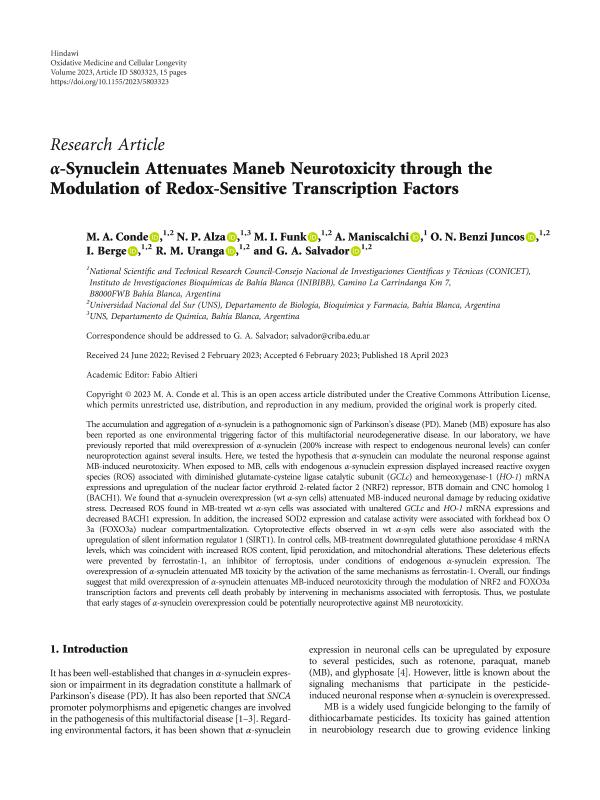Mostrar el registro sencillo del ítem
dc.contributor.author
Conde, Melisa Ailén

dc.contributor.author
Alza, Natalia Paola

dc.contributor.author
Funk, Melania Iara

dc.contributor.author
Maniscalchi Velásquez, Athina del Valle

dc.contributor.author
Benzi Juncos, Oriana Nicole

dc.contributor.author
Bergé, Ignacio

dc.contributor.author
Uranga, Romina Maria

dc.contributor.author
Salvador, Gabriela Alejandra

dc.date.available
2023-12-28T11:35:07Z
dc.date.issued
2023-04
dc.identifier.citation
Conde, Melisa Ailén; Alza, Natalia Paola; Funk, Melania Iara; Maniscalchi Velásquez, Athina del Valle; Benzi Juncos, Oriana Nicole; et al.; α-Synuclein attenuates maneb neurotoxicity through the modulation of redox-sensitive transcription factors; Landes Bioscience; Oxidative Medicine and Cellular Longevity; 2023; 5803323; 4-2023; 1-15
dc.identifier.issn
1942-0900
dc.identifier.uri
http://hdl.handle.net/11336/221707
dc.description.abstract
The accumulation and aggregation of α-synuclein is a pathognomonic sign of Parkinson's disease (PD). Maneb (MB) exposure has also been reported as one environmental triggering factor of this multifactorial neurodegenerative disease. In our laboratory, we have previously reported that mild overexpression of α-synuclein (200% increase with respect to endogenous neuronal levels) can confer neuroprotection against several insults. Here, we tested the hypothesis that α-synuclein can modulate the neuronal response against MB-induced neurotoxicity. When exposed to MB, cells with endogenous α-synuclein expression displayed increased reactive oxygen species (ROS) associated with diminished glutamate-cysteine ligase catalytic subunit (GCLc) and hemeoxygenase-1 (HO-1) mRNA expressions and upregulation of the nuclear factor erythroid 2-related factor 2 (NRF2) repressor, BTB domain and CNC homolog 1 (BACH1). We found that α-synuclein overexpression (wt α-syn cells) attenuated MB-induced neuronal damage by reducing oxidative stress. Decreased ROS found in MB-treated wt α-syn cells was associated with unaltered GCLc and HO-1 mRNA expressions and decreased BACH1 expression. In addition, the increased SOD2 expression and catalase activity were associated with forkhead box O 3a (FOXO3a) nuclear compartmentalization. Cytoprotective effects observed in wt α-syn cells were also associated with the upregulation of silent information regulator 1 (SIRT1). In control cells, MB-treatment downregulated glutathione peroxidase 4 mRNA levels, which was coincident with increased ROS content, lipid peroxidation, and mitochondrial alterations. These deleterious effects were prevented by ferrostatin-1, an inhibitor of ferroptosis, under conditions of endogenous α-synuclein expression. The overexpression of α-synuclein attenuated MB toxicity by the activation of the same mechanisms as ferrostatin-1. Overall, our findings suggest that mild overexpression of α-synuclein attenuates MB-induced neurotoxicity through the modulation of NRF2 and FOXO3a transcription factors and prevents cell death probably by intervening in mechanisms associated with ferroptosis. Thus, we postulate that early stages of α-synuclein overexpression could be potentially neuroprotective against MB neurotoxicity.
dc.format
application/pdf
dc.language.iso
eng
dc.publisher
Landes Bioscience

dc.rights
info:eu-repo/semantics/openAccess
dc.rights.uri
https://creativecommons.org/licenses/by-nc-sa/2.5/ar/
dc.subject
MANEB
dc.subject
NEUROTOXICITY
dc.subject
NRF2
dc.subject.classification
Bioquímica y Biología Molecular

dc.subject.classification
Ciencias Biológicas

dc.subject.classification
CIENCIAS NATURALES Y EXACTAS

dc.title
α-Synuclein attenuates maneb neurotoxicity through the modulation of redox-sensitive transcription factors
dc.type
info:eu-repo/semantics/article
dc.type
info:ar-repo/semantics/artículo
dc.type
info:eu-repo/semantics/publishedVersion
dc.date.updated
2023-12-26T14:23:04Z
dc.identifier.eissn
1942-0994
dc.journal.volume
2023
dc.journal.number
5803323
dc.journal.pagination
1-15
dc.journal.pais
Estados Unidos

dc.journal.ciudad
Austin
dc.description.fil
Fil: Conde, Melisa Ailén. Consejo Nacional de Investigaciones Científicas y Técnicas. Centro Científico Tecnológico Conicet - Bahía Blanca. Instituto de Investigaciones Bioquímicas de Bahía Blanca. Universidad Nacional del Sur. Instituto de Investigaciones Bioquímicas de Bahía Blanca; Argentina. Universidad Nacional del Sur. Departamento de Biología, Bioquímica y Farmacia; Argentina
dc.description.fil
Fil: Alza, Natalia Paola. Consejo Nacional de Investigaciones Científicas y Técnicas. Centro Científico Tecnológico Conicet - Bahía Blanca. Instituto de Investigaciones Bioquímicas de Bahía Blanca. Universidad Nacional del Sur. Instituto de Investigaciones Bioquímicas de Bahía Blanca; Argentina. Universidad Nacional del Sur. Departamento de Química; Argentina
dc.description.fil
Fil: Funk, Melania Iara. Consejo Nacional de Investigaciones Científicas y Técnicas. Centro Científico Tecnológico Conicet - Bahía Blanca. Instituto de Investigaciones Bioquímicas de Bahía Blanca. Universidad Nacional del Sur. Instituto de Investigaciones Bioquímicas de Bahía Blanca; Argentina. Universidad Nacional del Sur. Departamento de Química; Argentina
dc.description.fil
Fil: Maniscalchi Velásquez, Athina del Valle. Consejo Nacional de Investigaciones Científicas y Técnicas. Centro Científico Tecnológico Conicet - Bahía Blanca. Instituto de Investigaciones Bioquímicas de Bahía Blanca. Universidad Nacional del Sur. Instituto de Investigaciones Bioquímicas de Bahía Blanca; Argentina
dc.description.fil
Fil: Benzi Juncos, Oriana Nicole. Consejo Nacional de Investigaciones Científicas y Técnicas. Centro Científico Tecnológico Conicet - Bahía Blanca. Instituto de Investigaciones Bioquímicas de Bahía Blanca. Universidad Nacional del Sur. Instituto de Investigaciones Bioquímicas de Bahía Blanca; Argentina. Universidad Nacional del Sur. Departamento de Química; Argentina
dc.description.fil
Fil: Bergé, Ignacio. Consejo Nacional de Investigaciones Científicas y Técnicas. Centro Científico Tecnológico Conicet - Bahía Blanca. Instituto de Investigaciones Bioquímicas de Bahía Blanca. Universidad Nacional del Sur. Instituto de Investigaciones Bioquímicas de Bahía Blanca; Argentina. Universidad Nacional del Sur. Departamento de Química; Argentina
dc.description.fil
Fil: Uranga, Romina Maria. Consejo Nacional de Investigaciones Científicas y Técnicas. Centro Científico Tecnológico Conicet - Bahía Blanca. Instituto de Investigaciones Bioquímicas de Bahía Blanca. Universidad Nacional del Sur. Instituto de Investigaciones Bioquímicas de Bahía Blanca; Argentina. Universidad Nacional del Sur. Departamento de Química; Argentina
dc.description.fil
Fil: Salvador, Gabriela Alejandra. Consejo Nacional de Investigaciones Científicas y Técnicas. Centro Científico Tecnológico Conicet - Bahía Blanca. Instituto de Investigaciones Bioquímicas de Bahía Blanca. Universidad Nacional del Sur. Instituto de Investigaciones Bioquímicas de Bahía Blanca; Argentina. Universidad Nacional del Sur. Departamento de Química; Argentina
dc.journal.title
Oxidative Medicine and Cellular Longevity

dc.relation.alternativeid
info:eu-repo/semantics/altIdentifier/doi/http://dx.doi.org/10.1155/2023/5803323
dc.relation.alternativeid
info:eu-repo/semantics/altIdentifier/url/https://www.hindawi.com/journals/omcl/2023/5803323/
Archivos asociados
